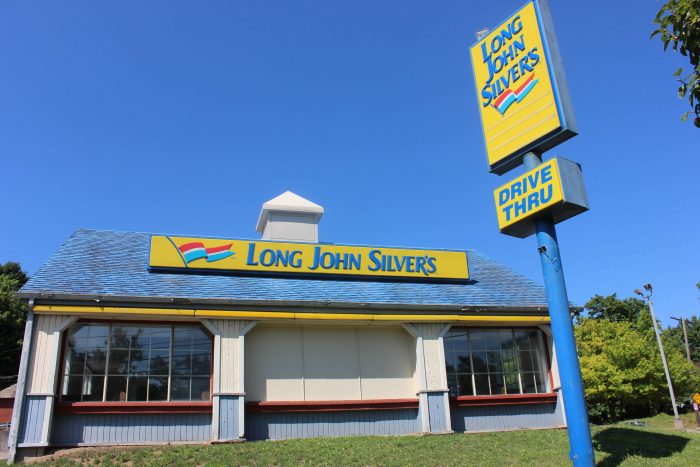
On a recent drive through my childhood neighborhood in Pittsburgh, I passed a long-abandoned Long John Silver’s (LJS), a seafood restaurant chain. A few weeks later, driving through Morgantown, West Virginia, I spotted a shiny, new LJS. The building was done in a modern style with bright blue paneling and an updated fish logo. This new building was shocking because I thought the brand was a sunken ship after seeing the outdated restaurants in Pittsburgh.
I decided I needed to dive deeper into this. On their website, LJS has a “Yes we still exist!” declaration plastered on their “Find A Restaurant” tab.
Long John Silver’s began in Lexington, Kentucky. The first restaurant opened in 1969 and grew to more than 1,000 restaurants between 1970-1979, and continued expanding through the 1980s. This year is the restaurant’s 50th anniversary. A major point the company left off their timeline, however, was years of financial struggle.
Under the nine-year management of Louisville-based, Yum! Brands, Inc., LJS saw visible decline. In 2010 Treasure Isles Inc., a Lexington-based company that operated LJS and A&W restaurants, filed for bankruptcy and sued Yum. They accused Yum of failing “to support the co-branded restaurants with marketing and struck a deal with a group of owners of stand-alone A&W restaurants that led to increased costs.”

The LJS and A&W co-branding was certainly confusing. A&W had a classic diner ascetic and menu with typical American fare like burgers and fries, while LJS had a Cape Cod-cottage style and seafood menu. Eventually, the floundering venture led Yum, also the parent company of KFC, Taco Bell, and Pizza Hut, to abandon ship and sell LJS to franchisee groups in 2011.
In 2013, a consumer advocacy organization, the Center for Science and the Public Interest, rated LJS’s “Big Catch” the worst restaurant meal in America. Breaded fried fish, hush puppies, and onion rings meant over 1,300 calories, not to mention an incredibly concerning amount of sodium and fat. This negative media attention did little to help the brand.
Luckily for LJS, the tide turned in 2015 when a new CEO, James O’Reilly, took the helm. O’Reilly, realizing there were bigger fish to fry than just finances, used his marketing background to make branding changes. He initiated a new logo, store design, and employee uniforms. In addition to these new stores, LJS updated its menu, introducing healthier options like grilled salmon and rice.

A complete turnaround is still in progress, but does LJS even have a devoted customer base?
Around Pittsburgh, at least, some locations keep attracting customers. One friendly Duquesne location worker I spoke with on the phone said, “They [LJS] have been open longer than I’ve been alive so over 36 years.” Similarly, a West Mifflin employee told me that the location has been operating for 20 or 30 years.
In the Appalachian Americans Facebook group, a poll about LJS grabbed the interest of more than 2,000 people. I posted the poll to gauge whether people still visited their local LJS.

Individuals added 18 other choices to my poll responses and 194 people submitted responses in the form of comments. The overwhelming response with 967 votes was: Yes, there is a LJS near me and I have eaten there in the past year. Again, this indicates some type of interest in the chain.
Alas, LJS still receives negative feedback from consumers. “I’ve only eaten there twice both times I got sick. The first time I thought it was because I was pregnant. But the 2nd time no excuse,” one commenter said. “I go once a year to get my oil changed,” another commenter stated.
Suffice to say, the popularity of LJS is a complicated question. Only time will tell if the brand can get its ship in order. Until then LJS will continue to promote and reinvent its brand to appeal to changing market and customer demands.
This July they are using social media to promote the “Fishmas” campaign. Fishmas is modeled after Christmas in July but with a beachy twist. They are giving away towels, bathing suits, modeled after ugly sweaters, and flip flops in place of slippers. LJS has also released The Fishmas Album. Songs include “Shark! Harold the Angler Sing” and “Jingle Shells.”
On Twitter, the brand reaches 32.2k subscribers but on SoundCloud (33 followers) and Instagram (4,401 followers), the reach isn’t as great. Only LJS marketing employees can say for sure if the social media campaign has worked. What is clear is that the brand is committed to trying new strategies to stay afloat.
Annie Chester is a writer and co-founder of expatalachians. She writes on environment and culture in Appalachia and abroad. She was an English teacher on the Island of Corsica, France. Now, she’s an Appalachian Food Justice Fellow.
Subscribe to The Patch, our newsletter, to stay up-to-date with new expatalachians articles and news from around Appalachia.


